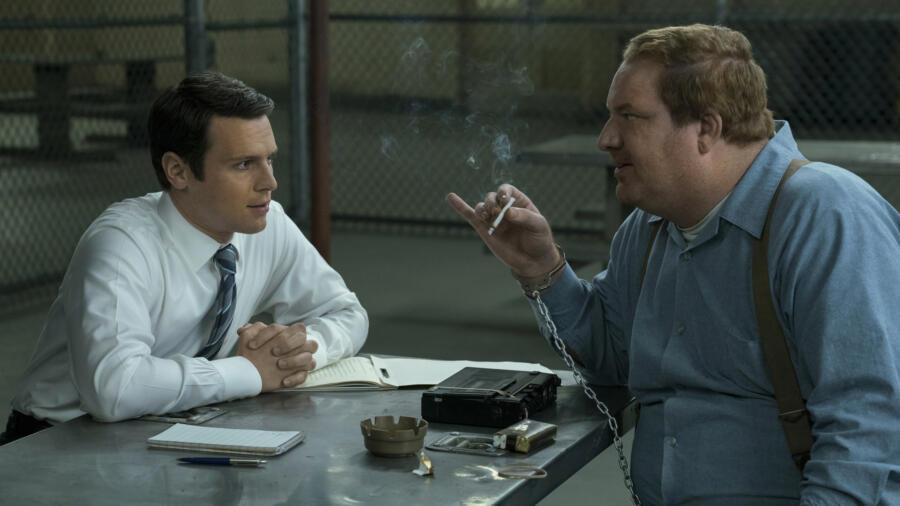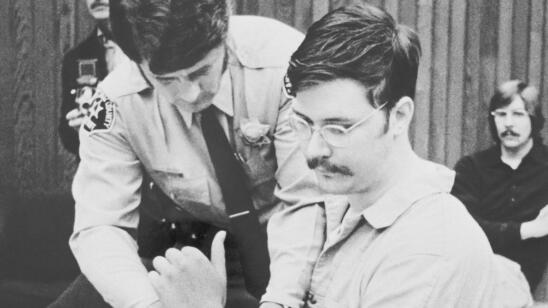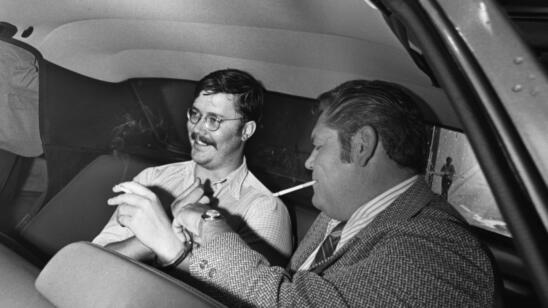The Netflix series Mindhunter is a runaway success (it’s 97 percent “fresh” on Rotten Tomatoes), and for good reason. The show puts an engaging, fictionalized spin on the small team of experts who launched the FBI’s serial crime profiling unit in the 1970s, revealing fascinating insights about the minds and motives of real serial killers— before the term “serial killer” officially existed.
On the show, agents Holden Ford and Bill Tench, based on FBI profilers John Douglas and Robert Ressler, learn on their feet as they interview a slew of creepy criminals, probing for clues about what drives them to kill. Though most of the real-life murderers portrayed in the series aren’t household names of the Jeffrey Dahmer and Ted Bundy ilk, their crimes are equally heinous.
A&E True Crime spoke with a psychologist and a criminal profiler about some of the murderers featured on Mindhunter, and asked them what the show got right when it comes to their impulses and motives. Be advised that just like the show, the brutal details of their ruthless crimes are not for the faint of heart so read on with the lights on.
Edmund Kemper (a.k.a. “the Co-Ed Killer”)
On Mindhunter, Ed Kemper, impeccably portrayed by Cameron Britton, is a 6’9″ hulk who appears sick but also fragile; he attempts suicide when Special Agent Ford fails to acknowledge receipt of the many greeting cards Kemper sent him after their first meeting.
After murdering his grandparents at age 15, Kemper was institutionalized until 21. This gave him ample time, between May 1972 and April 1973, to abduct and murder six college students, as well as his mother and her best friend. He also decapitated his victims, had sex with their severed heads and reportedly cooked some of their flesh in a macaroni casserole. At his 1973 trial, Kemper requested to be punished for his crimes via “death by torture.”
In this episode of PD Stories, Tom Morris Jr. is joined by retired FBI Profiler Mary Ellen O’Toole who explains what it is like to get inside the mind of a killer.
Why He Killed (According to Him)
Kemper blamed his alcoholic mother for his issues. When asked why he picked college girls as his victims, he admitted, “I was … involved in killing co-eds because my mother was associated with college work. … My mother was a sick, angry, hungry and very sad woman. I hated her.”
Though he broke down crying while describing killing his mom, Kemper admitted to “humiliating her corpse” and declared, “six young women [are] dead because of the way she [raised] her son.”
Why He Killed (According to Experts)
Dr. Carole Lieberman, forensic psychiatrist, concurs that Kemper’s murderous rage was driven by his hatred for his mother. “His mother’s [treatment of him] drove him to develop an antisocial or psychopathic personality, already evident in early childhood when he killed and dismembered cats,” she explains. “After he murdered and sexually violated his mom and her friend, he lost his bloodlust.” (He turned himself in at that point.)
Criminal profiler John Kelly of S.T.A.L.K., Inc., agrees, noting that “all these guys, at their core, are running on rage. Often the father is not around, which fits perfectly here, and many [like Kemper] had a critical, demeaning, abusive mother.”
Monte Rissell
Monte Rissell was a long-time criminal who started raping women when he was only 14 years old. But after catching his ex in bed with her new beau, Rissell, then 18, seemed to snap. On Mindhunter, actor Sam Strike, portraying Rissell, describes raping and killing a prostitute in an impulsive act of revenge against his ex. He later raped and murdered four more women.
Why He Killed (According to Him)
In addition to blaming his first murder on his former lover, on Mindhunter Rissell identifies as a victim himself, saying, “Nobody on this earth ever wanted me. Put that on your f****** tape.”
He may have also fit the “missing father, difficult mother” pattern mentioned by Kelly. Rissell had no relationship with his dad after his parents’ divorce, and on the show, the Rissell character bemoans how his mother allegedly dragged him and his siblings around the country and neglected them.
Why He Killed (According to Experts)
“When [Rissell’s first victim] tried to defuse the rape by [feigning pleasure], he became more enraged and killed her,” says Lieberman.
Kelly explains his actions more simply: “He freaked out.” Kelly continues, “With Kemper you saw organizational skills, but Rissell was disorganized. He got overpowered by rage and wanted to soothe it by getting into the hunt, the attack, the kill.”
Jerry Brudos (aka “The Shoe Fetish Slayer”)
Jerry Brudos was convicted of methodically killing at least four women between 1968 and 1969 in Oregon. He also had a lifelong shoe fetish that appeared to have begun when he found a pile of stilettos in a junkyard at age five.
Brudos first abducted a woman when he was 17. He assaulted her, forced her to strip and photographed her naked. After getting caught, he was sent to a psychiatric hospital. Upon his eventual release, he married and had kids, but continued to indulge his fetish for women’s shoes and underwear, even sneaking into neighbors’ homes to steal theirs.
He raped and strangled his first victim in 1968: a 19-year-old encyclopedia saleswoman who’d stopped by his family’s house. He cut off one of the young woman’s feet as a trophy and kept it to photograph. Brudos, also a necrophiliac, died in prison in 2006.
Why He Killed (According to Him)
On Mindhunter, the Brudos character is incredibly evasive, denying murders he’d previously confessed to and essentially sending the agents on a wild goose chase. He, too, admits to a tumultuous relationship with his mother (who, for what it’s worth, reportedly wore sensible shoes: anathema to Brudos).
Why He Killed (According to Experts)
Lieberman and Kelly agree that Brudos, whom Kelly describes as a “live wire,” was at least partially triggered by an abusive mother who admitted to wishing she’d given birth to a girl instead. Lieberman explains, “[Brudos’] obsession with high heels and women’s underwear was fueled by both his unconscious desire to ‘be’ a girl, and to be sexually gratified by possessing these objects.”
Richard Speck
In the summer of 1966 in Chicago, Richard Speck hog-tied, strangled and stabbed nine student nurses in a random spree while they were sleeping. All but one of them died. Speck, a 24-year-old drifter and repeat criminal looking for work, didn’t deny killing the women, but claimed he’d been blackout-drunk and unaware of what he was doing. Later, when fellow prisoners asked why he’d done it, he laughed as he confessed that “it just wasn’t their night.”
Why He Killed (According to Him)
In Mindhunter, the agents seem confounded by Speck, who comes off as especially unpredictable and angry. They note his “Born to Raise Hell” tattoo as a sign that Speck is living out a self-fulfilling bad-boy fantasy, but his motives for the massacre remain murky. (Indeed, some experts considered his killing spree to be “the first random mass murder” of the 20th century).
Why He Killed (According to Experts)
Kelly isn’t buying the now-deceased Speck’s claim that he was too drunk to know what he was doing. “Speck is a lying son of a gun,” Kelly says. The murder spree lasted five hours, and Kelly notes, “There’s no way he could be in a blackout for that long.”
Lieberman believes Speck’s fury was directed at three women in particular: his mother, his wife (who had divorced him that year) and his sister. In July 1966, his elder sister, Martha, a nurse, finally told him that he couldn’t continue staying with her. “After [a day of] drinking, he lost his inhibitions and let out the rage he felt towards his mother, his ex-wife and his sister … on the 8 nurses he murdered,” Lieberman theorizess.
Dennis Rader (“BTK”)
An ADT salesman who appears in shadowy, unexplained scenes throughout Mindhunter’s first season bears a notable resemblance to Dennis Rader (aka “BTK,” or “Bind, Torture, Kill”). Though the agents don’t interview him (they don’t have reason to yet), it seems clear he’ll be a fixture in the show’s second season.
Rader, who murdered 10 people in the Wichita, Kansas, area between 1974 and 1991, taunted police and chased fame with clues, letters and notes before finally being arrested in 2005. He was cold and calculated, and his murders were largely driven by his sexual compulsions. (He later described his victims as “projects” or “hits.)
“He’s the worst of the worst,” per Kelly. Not only was Rader incredibly smart, he also hid in plain view for more than 30 years. He graduated from college, had a good job (and led a Boy Scout troop), had a wife and family and was active at church. He was also able to quell his murderous urges for many years, which Kelly says is unusual for serial killers: “Between the last murder and the time of his arrest, he had a 14-year cooling off period.”
It’s his seeming normalcy that makes Rader so frightening. “I can’t find childhood abuse or attachment disorder [with Rader]. This is the guy in my nightmares,” Kelly says.
Related Features:
Was Serial Killer Wayne Williams Really the Atlanta Monster Who Murdered Dozens of Black Kids?
How to Talk to Serial Killers: An Interview with ‘Mindhunter’ John Douglas
Edmund Kemper: Why Would a Serial Killer Help the FBI Understand Other Serial Killers?


